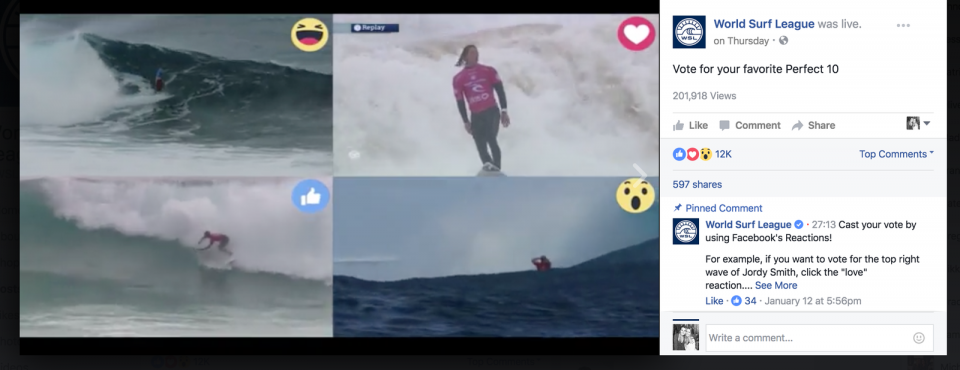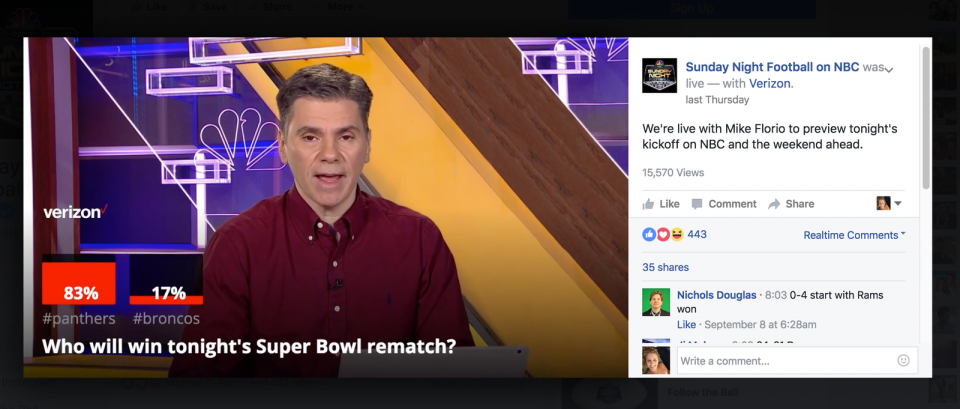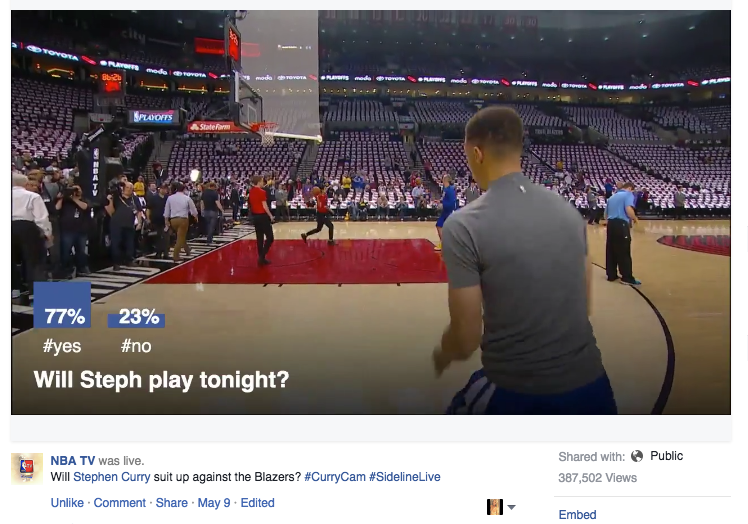SVG Sit-Down: Telescope CEO Jason George on the Future of Live Social Video
He sees ‘nirvana’ in rich video content as part of a two-way conversation with the audience
Story Highlights
Since debuting a little over a year ago, Facebook Live has captured the imagination of sports fans and content creators alike, becoming an integral and essential part of the sports ecosystem. Telescope’s award-winning Live Studio platform provides an interactive experience for Facebook Live, enabling content creators to build and customize their live video, engage with their audience, and realize monetization opportunities through integrated branded-content and sponsorship tools. SVG sat down with Telescope CEO Jason George to discuss the company’s growing role in the dynamic live-social-video world and its continued support of SVG’s Facebook Video Boot Camp.
What do you see as Telescope’s niche in the live social video?
We’ve been around for 15 years, and we’ve always lived at the intersection of television and audience participation. I think our traditional business helped people transition from a traditional TV experience into second-screen participation: interacting with the on-air experience, soliciting and curating user comments, and then bringing that content back into the on-air experience.
We’ve watched these mediums evolve, and we’ve adapted by migrating our products and services to OTT platforms as consumption has migrated to those platforms. We’ve developed a great relationship with key social platforms as they’ve reached mass-scale, and have become a particularly close partner of the Facebook Media Solutions team. With Facebook Live, we were launch partners when they announced their API allowing premium-content producers to publish quality professional content into their Facebook pages.
What’s fascinating to me about Facebook Live — as well as Twitter/Periscope — is that this nirvana we’ve been reaching for over the last 15 years finally feels within touching distance: for rich video content to be part of a two-way conversation with the audience, rather than a one-way broadcast. That participation on these platforms feels organic to the whole experience, not something that’s bolted on. It’s not expensive, it’s not clunky, and it feels totally natural. Pretty soon, that will become the baseline for what viewers expect from their content experience wherever they’re watching. It will be the de facto standard, and whole new forms of content will evolve from it. That to me is what’s really exciting.
Telescope, through the Live Studio Platform, has been a big supporter of SVG’s Facebook Video Boot Camp. Why is it important for you to support this endeavor, and what do you see as the importance of Facebook Video in the sports industry?
Social video in general, is growing exponentially, and Facebook has taken a dominant position in the live–social-streaming space. Reach plays a major part in that: they simply have more eyeballs than all their competitors with the exception of YouTube (if you view them as a social platform). The second major benefit we see from Facebook’s platform is its ability to drive content discovery and awareness: as an example, roughly half of live-content viewing is discovered through somebody seeing it in their news feed. They didn’t make an appointment to view; they saw it in their feed and reacted to it. In other words, driving fans to share, comment, and like in itself helps prioritize that content within the algorithm and surface it to other potential viewers. That combination of rich content with promotion to viewers that might not otherwise have found that video via the algorithm is a powerful formula and pretty unique to Facebook at the moment, certainly at that sort of scale.
 The World Surf League, which presented at SVG’s Facebook Video Boot Camp in L.A. in July, is a great example of a sport using Facebook Video. Specifically because surfing is weather-dependent, they have a challenge for conventional broadcasting: when they wake up in the morning, they don’t know for sure if they’re going to be on that day. The waves rule them! They also have a passionate global audience, which, with Facebook, they can reach and activate. They can notify their fans when things are happening and drive people to that broadcast, and they can set up and tear down their production hub from anywhere. They’ve become really adept at getting FB Live produced remotely at a high quality, driving viewership and integrating their audience into the experience.
The World Surf League, which presented at SVG’s Facebook Video Boot Camp in L.A. in July, is a great example of a sport using Facebook Video. Specifically because surfing is weather-dependent, they have a challenge for conventional broadcasting: when they wake up in the morning, they don’t know for sure if they’re going to be on that day. The waves rule them! They also have a passionate global audience, which, with Facebook, they can reach and activate. They can notify their fans when things are happening and drive people to that broadcast, and they can set up and tear down their production hub from anywhere. They’ve become really adept at getting FB Live produced remotely at a high quality, driving viewership and integrating their audience into the experience.
A lot of the focus at the moment is “shoulder content” — non-game content, especially reactive “up close and personal” stuff like live player interviews from the locker room or Q&As with players. Enabling fans all over the world to get closer to their idols deepens affinity with the sport, and that drives people to watch more games and, in turn, ultimately raises the value of those sports rights. The OTT players have been dipping their toe in the bigger pond around major sports rights, but that’s going to pick up over the next 18-24 months. Amazon already secured the rights to stream Thursday Night Football games, and the other platforms have been in the bidding process for the first time. To me, this is a natural fit for the likes of Facebook and Twitter especially, given their ability to create fan engagement, drive viral marketing and discovery through their networks.
In terms of why we’re behind the Boot Camps [SVG has] been putting on with Facebook, the learning curve since we launched in April 2016 has been incredible. But it’s still a very nascent industry, and we need to educate new entrants about the benefits and how to get started, as well as existing content owners on there about how to get the most out of it.
Just one example of how things have evolved over time. At first, when you started a Facebook Live broadcast, you just hit the button. and off you went. But, of course, given the social nature of Facebook and what I said [about] discovery, viewers would come into that broadcast having seen it in their news feed because of a friend share or comment. But they’d have missed the first five minutes! So Facebook created a scheduling tool allowing publishers to promote a Live up to a week in advance; followers also get notified and can opt in for a reminder.
 Sharing information and best practices like this is really important, and part of the journey. Getting end-customer feedback on Facebook features they’d like to see as well as on our Live Studio platform is gold dust for us. When you’re in the middle of it every day, sometimes, you can’t see the wood for the trees, but getting direct feedback from fresh eyes really helps and is great for us in evolving our products.
Sharing information and best practices like this is really important, and part of the journey. Getting end-customer feedback on Facebook features they’d like to see as well as on our Live Studio platform is gold dust for us. When you’re in the middle of it every day, sometimes, you can’t see the wood for the trees, but getting direct feedback from fresh eyes really helps and is great for us in evolving our products.
A big question surrounding live social video is the question of monetization. Are you having more conversations about monetization? What are the big hurdles?
At the moment within Facebook, there’s branded content: you can integrate sponsorships with FB Live video within certain guidelines, and the content owner can keep all the revenue. Facebook is also trialing mid-roll ads at the moment with selected publishers, and, if that eventually rolls out, it will be another piece of the jigsaw. Personally, I think they’re playing the long game and it’s smart: they want to test and evolve their monetization products to make sure they’re right for the audience as well as advertisers. Facebook is very conscious of the user experience in all that they do. In time, I believe there will be a mass-scale marketplace that facilitates buying and selling of available inventory within all Facebook video assets. I think Facebook is going to be a major player in digital video, and monetization will be a key component of that, of course.
What do you see as the future of live social video as it pertains to the sports-fan experience?
I think it goes back to that whole thing around the two-way conversation it enables with fans, and everything that brings with it: getting fans closer to the teams and athletes they love.
A lot of athletes have huge followings, and I think the ability for them to, say, do simple Q&A-type sessions right from the locker room is going to be big. In terms of the future, I think you’re also going to see sports broadcasts happening more and more on those social platforms, with audience participation where the network or the league can speak directly to that audience and that audience can speak directly back.
Second, on monetization and how the data these platforms have can be used for targeting. With Facebook, you can see anybody that’s been to a stream, and you can retarget them. For example, if 70,000 people tuned in to my live video, I could follow up with a ticket-sale promotion, a merchandise offer, a partner concession, or maybe just a reminder that we’ve got another broadcast coming soon. I haven’t seen this capability utilized too much yet, but I think it’s a potential game-changer.
Imagine sitting down for that Thursday Night Football on Amazon. While watching, I can interact with my friends, get live comments from other fans, and take part in “gamification” like polls and predictions during the match. At the same time, I turn on real-time updates from my Fantasy League group, of course. But all this extra thinking is making me hungry, so I order pizza on Amazon Fresh; of course, it already knows my favorite pie so it only takes seconds. Oh, and I also fancy a new team shirt, so I order that on Amazon while I’m there (you guessed it: they already know my favorite player so the shirt comes customized).
All that is a very different experience from how we currently consume sports, but, believe me, it’s coming fast to a screen near you.

